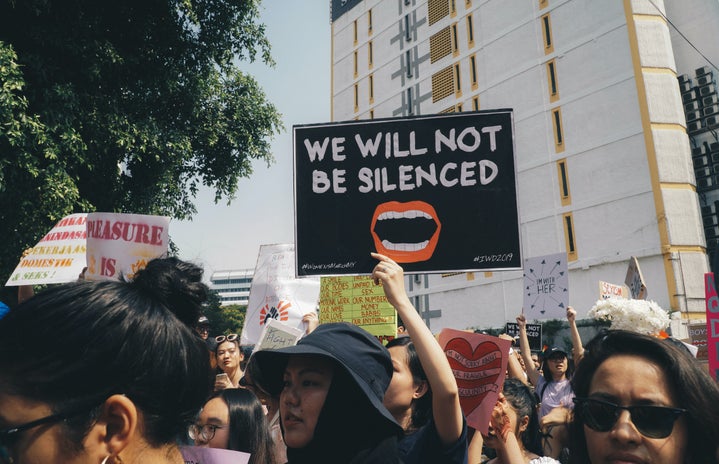*Trigger Warning: This article contains discussions about sexual violence and assault.
You’re walking back to your car after a late night, pepper spray in hand and keys wedged in your fist. You shared your location with a friend for an extra step of safety. You hear what sounds like footsteps behind you, and being too scared to look, feel yourself speeding up your pace. Finally, you make it to your car, immediately locking the doors.
There are countless stories of women who were “just walking home” when they were assaulted. This does not just include women who were walking home, but also going for a run, leaving a party, riding in public transportation, on a date, with someone they know and trust, and more.
You Gov America has conducted research on how women view their safety compared to men.
50% of women say they always or often feel unsafe walking alone at night.
6 in 10 women regularly take precautions to avoid sexual assault.
73% of women maintain awareness of their surroundings at all times compared to 48% of men.
60% of women avoid being out at certain times compared to 30% of men.
64% of women inform friends of their location compared to 28% of men.
Huff Post has also complied statistics on sexual assault in the United States.
17,700,000 women are estimated to be victims of sexual assault since 1998.
99% of sexual violence perpetrators will walk free.
16 to 19-years-old is the age range of women that are four times more likely to be sexually assaulted.
Female college students are three times more likely than the rest of the population to be sexually assaulted.
7 in 10 perpetrators are someone the survivor knows.
These statistics are distressing and alarming, and they only contain information about assaults that have been reported; there are countless sexual assaults that also go unreported. Sexual assault in the United States is dangerously rampant. It is also important to note that sexual assault is not just a problem for female-identifying individuals; it can happen to any individual.
While there are apps, phone services, and emergency stations on college campuses that are meant to help prevent assaults like this, there is only so much they can really do.
Something that needs to be dismantled is the thought process that sexual assault is somehow the survivor’s fault; it is never the survivor’s fault. It does not matter what they were wearing, if they were drinking, how many sexual partners they’ve had, etc. No one is asking to be sexually assaulted and it is an extremely traumatic experience for any individual.
Instead of telling women why they should take precautions to not be sexually assaulted, we need to start emphasizing consent, holding perpetrators accountable, and holding men to higher standards. If we keep only talking about ways that women can prevent themselves from being sexually assaulted, girls will continue to grow up believing that sexual assault is normalized for them.
The media, including movies, television, music, and more also reinforce sexualizing women and even the normalization of sexual assault. All of this stems from a patriarchal society that equates power with privilege and places cisgender men at the top of that power. I could go on about how the patriarchy is the central problem of the sexualization of women and normalization of sexual assaults against women, and how certain individuals of power in politics have reinforced this along the way…but that deserves an article of its own.
Sexual assaults on college campuses seem to be even more prevalent, with female college students being three times more likely than the rest of the population to be sexually assaulted, according to Huff Post.
Office of Women’s Health has also looked into sexual assault statistics specifically on college campuses.
One in five college women will experience sexual assault.
One in three students faced trouble with academics following their sexual assault.
One in five college women that are assaulted reports it to the police.
15% of college women experience incapacitated sexual assault in their first year of college, one study found.
When a sexual assault is reported on campus, it is required that the institution publicly report the assault if they receive federal funding. Universities are also required to help students continue their education following their sexual assault. Universities that receive federal funding can also offer counseling and other resources, according to the Office of Women’s Health.
However, colleges often handle reporting a sexual assault through an administrative or legal form, rather than a counseling approach. There is more at the higher levels of institutions that needs to be done regarding communication and education about sexual assault.
First, in addition to the required notices of campus sexual assaults, resources should also be sent to all students from individuals with experience in trauma, social work, therapy, etc. Individuals in these fields have the knowledge and experience about these circumstances than other university administrators. Individuals with backgrounds in trauma and therapy have been extensively trained and educated for circumstances just like these, and know how to communicate about an assault at an emotional and counseling level.
Second, colleges need to make clear which resources for sexual assault are confidential and which are not, and where students can find this information. Many students may be fearful or overwhelmed to report or even go in for a health screening following their assault due to confusion about confidentiality, especially if it is their first year of college. Survivors of sexual assault have every right to not report, and colleges could make it more clear and accessible which resources for them are mandated reporters and which are not. This way students can still receive counseling and other resources without having to report it to the police. Here are Cal Poly’s sexual assault resources (non-confidential and confidential): https://chw.calpoly.edu/counseling/sexual-assault-resources
These are just two things that could be done to improve communication about sexual assault to students. There are still many more things, but these are good first steps.
The truth is it is hard to talk about sexual assault, and it is hard to look at those statistics because that is real life, and that is what really happens.
Girls do not want to just walk home. They also want to go to parties, go on dates, and do normal, everyday activities without having a constant fear that something bad is going to happen to them simply because they are a woman.


